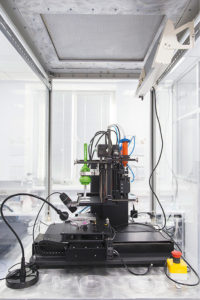 The concept of 3D printing sounds like something out of a sci-fi film, but it has the real-life potential to change the way we eat, interact, and even heal. The entire medical field could be impacted by this emerging technology in ways we might never have considered. Everything from prosthetic limbs to human tissue replacement can be created with a 3D printer. And in many cases, these offerings may be preferential to both doctors and patients.
The concept of 3D printing sounds like something out of a sci-fi film, but it has the real-life potential to change the way we eat, interact, and even heal. The entire medical field could be impacted by this emerging technology in ways we might never have considered. Everything from prosthetic limbs to human tissue replacement can be created with a 3D printer. And in many cases, these offerings may be preferential to both doctors and patients.
One of the most surprising areas where 3D printing can be used? Right in your mouth. Around 90% of people who suffer from edentulism (or missing teeth) have dentures, but conventional methods can lead to a poor fit, irritation, and general disruption of daily activities like speaking and eating. A recent clinical trial found that, when people in their 60s alternated between traditional dentures and 3D printed ones, 55.5% of participants preferred the 3D printed versions. Researchers also reported that “participants reported fewer complaints and more compliments when they were using the laser-sintered RPDs than when using the cast RPDs.”
This increased level of satisfaction may be largely due to the fact that 3D printed dentures can be more precisely made (thus creating a better fit). In addition, participants said the 3D printed dentures were easier to clean and were generally less bulky than the traditional kind. While the sample size in this trial was quite small and there are factors that make the technology inaccessible for all patients (the high cost and expertise required, for instance), the positive reaction does hold promise for future applications.
But the possibilities of 3D printing extend far beyond the mouth and into the internal workings of the body itself. 3D printing can be used to combine several medications into one, all with different release times. That means that patients who have both hypertension and diabetes would need to worry about taking only one pill to get all of the medicine they need to manage their conditions.
Custom prosthetic limbs are also made possible with 3D printing. While the technology was already being used for pets with amputated limbs, it’s now being put into practice for humans. Ultimately, mass-production of prosthetics is likely to die out, as patients want options that are customized for their exact bodies and conditions.
Physicians will even be able to use 3D printing to make human tissue structures, eliminating the need for certain transplants. They can also use the technology to practice complex surgeries that might otherwise cause extra trauma or take additional time. This method will also save a considerable amount of money for hospitals in educational settings.
Just a few years ago, we might never have imagined that we could print replacement tissues, bones, or limbs to improve our well-being. But now, those technological advancements could mean better healthcare for countless people around the world.




